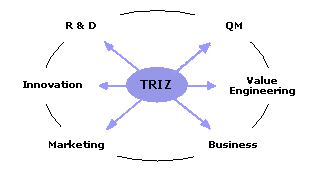|
|
|
TRIZ has the following advantages over traditional innovation supporting methods: |
|
|
 Application fields of TRIZ |
The TriSolver Approach enables all innovative thinkers to utilise the full potential of
TRIZ for following tasks and application fields: |
|
The most important components in TRIZ innovation technology can be summarised in the table
below with regard to the different ways of solving technical problems. The simpler methods, for example,
the 40 inventive principles, can be integrated more easily to be used as active tools but have some
restrictions as to their efficiency in solving complex problems. |
Nr. |
TRIZ - tools, methods |
Fields of application |
| 1. | 40 Inventive Principles for eliminating technical contradictions; system of their application in form of the Contradictions Table. | Simple to moderately difficult tasks, recommended for newcomers to TRIZ. |
| 2. | System of 76 Standards for solving technical problems: 5 classes / 76 Standards. | Simple to difficult tasks. |
| 3. | Step-by-step techniques or algorithms for inventive problem solving (abbr.: ARIZ). Universal tool for solving all kinds of problems. | Extremely difficult problems, comprehensive search for solutions. |
| 4. | Substance-Field analysis of technical systems. | Tools for methods nos. 2 and 3. |
| 5. | Separation principles for eliminating physical contradictions. | ARIZ tool (no.3). |
| 6. | Methods for analysing of system resources. | Tool for nos.2 and 3. |
| 7. | Database of physical, chemical, geometrical and other effects and their technical applications. | TRIZ knowledge base; tools for components nos. 1 to 5. |
| 8. | Methods to increase creative thinking, to reduce psychological inertia and to "leave beaten tracks": operator DTC (dimensions-time-cost), simulation with "Little People" etc. | Psychological aids for all TRIZ components. |
| 9. | Method of Anticipatory Failure Identification (AFI) in technical systems. | Analysis and prediction of possible sources of failures. |
| 10. | Patterns of evolution of technical systems (TS). | Prediction for the development of technical systems, creation of patent fences. |
| © 1998-2017 TriSolver Consulting |